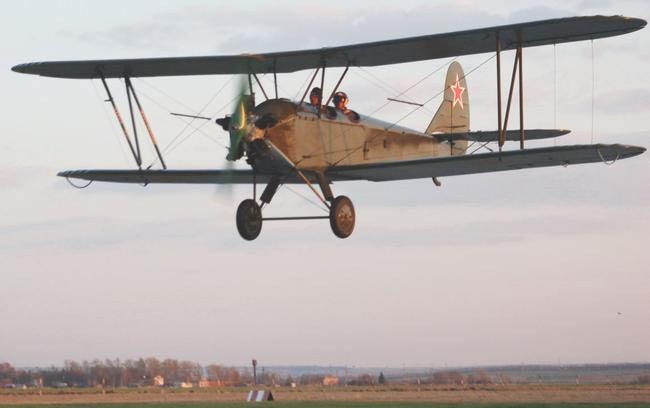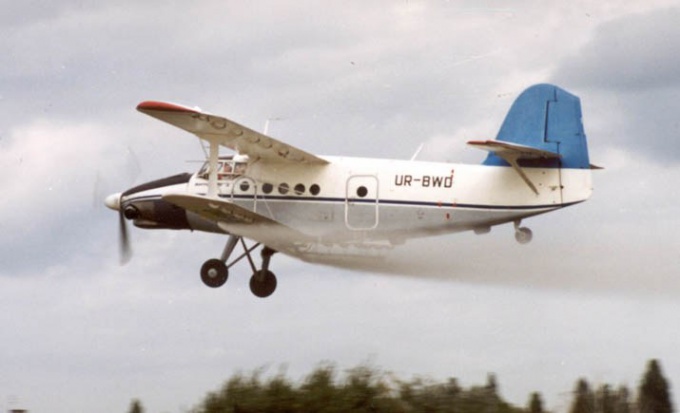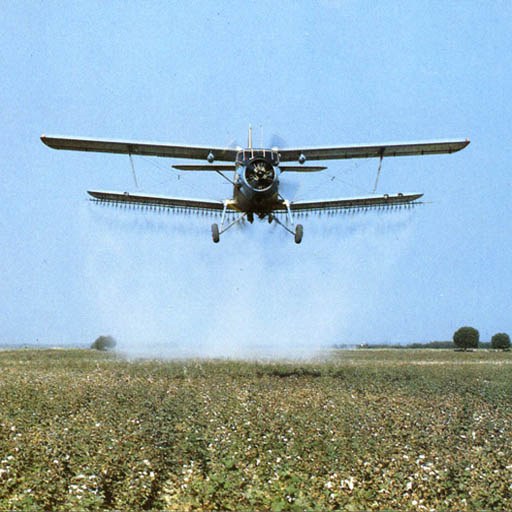Instruction
1
"Corncob" – a nickname inherited. Antonov an-2 is the most famous but not the first and not the last in this glorious race. The history of planes-crop dusters began with the USSR and continues to this day.
2
Background of the maize
5 main tasks the first five year plan included the development of animal husbandry. Scientists sounded the alarm: the meat consumption per capita fell to a catastrophic level. If you do not bring animal protein consumption to normal, degeneration of the people is inevitable.
Half-mad cruel despot Stalin and his minions is not to deny the strategic abilities, and prevention physicians was taken very seriously. The only way out saw the transition to stabling cattle in Czarist Russia practiced sporadically.
For housing the necessary cheap fodder for ruminants silos. The most abundant source – corn. In addition, it gives valuable grain and medicines. Therefore, even in the mid 20-ies of the last century the corn in the USSR began to introduce into the culture.
But overseas Priceline primarily relished domestic pests of agricultural crops: experimental crops eaten completely. It was necessary to develop and apply plant protection products.
Experiments in the fields established then still existing Institute of Plant Protection (VNIITR) showed high cost and low efficiency of manual or mechanized from land spraying with biocides. Then someone from the environment of Stalin (according to unconfirmed reports, Sergo Ordzhonikidze) suggested the use of aircraft. The solution for that time is far from trivial: selhozaviatsii only person in the world was still in its infancy.
3
The history of the name
For the first experiments was adapted for the spraying of a sports car Yakovlev air-1 and air-2. At first, the "corncob" nickname pilots on the farmers of their gallant colleagues, but soon the ironic nickname acquired honorable sense of work in the agricultural equipment until required extreme exertion, attention, and higher flight skill.
Machine for selhozaviatsii also had to be specific: cheap and easy to manufacture, economical (a lot of fuel was spent on the frequent take-offs and landings), reliable, not requiring a surface of the base, hardy, capable of running pilot of average skill long walk at low level flight, as they say – in following the terrain without continuous manual correction of the trajectory.
Ira satisfies most of these requirements. They were the first aircraft-"crop dusters". But one of the conditions of the machine, originally designed for flying clubs, not passed their flight resource was small, and on farms they have been ruined in just a season. The plane required a special design.
4
The first real corncob
I must say that the leaders of the USSR and designers to wrestle with the concept and creation of the new machines was not necessary: 7 January 1927 made the first flight, and in 1929 went to series legendary light multipurpose biplane U-2 (Po-2) construction. N. Polikarpov. Initially, the underlying qualities more abundantly satisfies all possible and impossible conditions. Including in the agricultural equipment until, in production and agricultural modification-2SKH, see Fig.
"Maize" 2 was automatically inherited. But in the pre-war years he was more famous as "the wolfhound", "Forester" and "orderly".
After the civil war enormously multiplied the wolves, their flocks of thousands in winter, devouring all living things, including humans; the mass extermination of predators from the air allowed us to take control of the wolf population. Also has been very effective air patrolling of forests and forest fires.
But the main merit of the Po-2 before the war – with his help managed to win the fight against malaria that killed people in the Caucasus and Central Asia. Cumulative water bodies (iStyle, houses) there for water saving densely obsesivos vegetation, became the nurseries of the transmitter of Plasmodium falciparum – Anopheles mosquito – and was available for sanitation only from the air.
For pilots it was a hell of a job associated with a fatal risk: a whole day with short breaks for food and a gas station, a dive for a dive in the green well. The slightest incorrect movement of the handle or pedals – and the end, of clearance there. Rescued, however, exceptional flying qualities For-2.
As for corn, by the mid 30's experiments with it were postponed. The agronomists could not understand the reasons for her vagaries, and for commodity of the animals managed to do clover, lupine and alfalfa.

5
The maize goes to war
Civil nickname In-2 because of the war the order was forgotten, but not because the maize was left in the rear. On the contrary, they were completely overshadowed by his military glory: plywood slow moving biplane with engine of 100 HP is unanimously considered the most successful aircraft of the Second world.
Light night bomber Po-2 was initially in the Wehrmacht laughter. They were called "Russian plywood", "grinders", "sewing machines". But soon the laughter was replaced by a menacing horror: night Po-2 quiet, on low-level with the muffled engine, cut the enemy's trenches, small bombs as steadily and methodically as infected weevil pesticides field.
Had maize to cross over to "the black death", as other legendary aircraft, the Il-2, the "night of the devil" and "vampire". "Russian plywood" did not cause the enemy strong direct damage, weak motor was not allowed to take a large combat load. But harassing raids proved extremely effective indirectly. In recognition of field Marshal von Bock, the loss of combat capability of soldiers just because they could not sleep, was not less than from direct daylight strikes the Il-2. Which was by no means weak.
"Heavenly slug" not tested in flight the big overloads, and so many shelves-2 manned by female crews. The Nazis called them "night witches" themselves took this name not as a metaphor. Known secret recommendation Ahnenerbe (Nazi mystical-esoteric services): captured the "night witch" in any case, not rape. Otherwise, they say, the Aryan spirit will disappear, and "ubermench" will turn into a subhuman.
6
Rebirth in a new quality
The war ended with the triumph of the Soviet Union, and the task was not to survive somehow, and to develop comprehensively. In this connection, re-acquired special importance of livestock and silage.
Meanwhile, it was discovered the secret of the vagaries of corn: it refers to the number of plants with the so-called Kranz syndrome. They need a lot of heat and light, but to indulge their greasy soil and adequate moisture should not be – the plant will switch your metabolism, productivity will fall and away from home in higher latitudes it is more and begin to hurt. This explains the final rooting of corn we have in the 50s, and speech "bald clown" Nikita Khrushchev is just the tip of the iceberg.
The transition to a corn silage were given the opportunity to release a lot of fertile land for food crops, but the pest of the corn is not lost. Again required the plane-kukuruznik, but not Po-2. Heavenly slug was still in production, but with the upcoming volumes of the work deal it obviously could not.
And again the car did not have to search: in 1947, flew the Antonov An-2. His concept is the same as that of Po-2: multi-purpose, cheap, economical and everlasting biplane. But economical engine, A. D. Shvetsov ASH-62IR 1,000 HP completely transformed the car: new maize raised more than 300 kg of payload with an effort, and half a ton free, and the supply of fuel to 1240 l allowed at cruising speed for farming 135-150 km/h to stay in the air for more than 6 hours without landing.
That is, the new duster could work full time, not ducking and then to the airport. As a result, the cost of the treatment fields decreased by 2-4 times and its use was economically justified. Why the An-2 became the maize forever.
7
The story continues
By the early 80s there is a need to replace the heart of maize. Developed before the war, the ASH-62IR did not satisfy the requirements of the time: after the oil crisis in the 70's the price of a barrel of oil jumped five times, and expensive aviation gasoline B-70 economic indicators do not fit.
Glider maize seemed (and proved) eternal, so it was decided to just change the motor for running on cheap kerosene turbo-prop engine (the HPT). So was born a new maize – EN-3, originally planned and selhozprodukti EN-3СХ, see Fig. The first flight of the An-3 made in 1980.
To pick up or make a turbine engine for the heavenly slow mover proved to be challenging, and when developed specifically for the An-2 in Omsk TVD-20 was brought, and the Union collapsed. Therefore, the new duster went into the series only in 2000. Rated power: 1350 HP allowed us to increase the commercial load up to 1800 kg, and the filling of chemicals for farming to 2200 L. Received An-3 also new appliances and radio navigation equipment.

8
The story continues
Experience has shown that the transfer of maize to the turbine turned out to be incorrect. TVD economical on cruise ships, where he remained for the duration of the flight operate in the optimal mode in "all hands" and kerosene it consumes too much for the current prices of petroleum products. Therefore, An-3 are well established only in emergencies, where fit was his incredible stamina and the "penetrating power". In 2009, the production of maize, a new generation was discontinued.
Meanwhile, the engine specialists, using computer modeling and advanced materials, made in the development of piston engines quiet but profound revolution. And need cars-"corncob" in no way diminished.
Old An-2 to be scrapped go, are laid. As a glider they still fly and fly, only the motors worn out. Therefore, in the same year 2009, the RF government resolution on the revival of the Park, An-2 based on the re-engine. And it turned out that the engine is worthy of the outstanding qualities of the maize, pick up ready-made very difficult abroad have forgotten how to do such long-lasting and durable motors.
However, work on the creation of a new "heart" of the An-2 is underway and we, I think, soon again you will see the corncob in the sky. The glorious tribe of the maize will not die and will not degenerate: they we all need.
9
Interesting facts
The first real biplane Po-2 during the war gave our another pleasant and foes a nasty surprise. The masses is little known that the radar was used rather extensively in the war. Air defense of Moscow and Leningrad provided the radar "Redut", and night fighter PE-3 with radar made a significant contribution to the destruction of the "air bridge", which the Germans tried to lay to surrounded in Stalingrad Paulus.
Had radar and the Germans, very good. But against 2, they were powerless: plywood and fabric for beam radar transparent. So heavenly slug and was even then by stealth.
An-2 three times entered in the Guinness Book of records: as the largest single-engine biplane in the world (until the appearance of An-3), as the most long-lived aircraft (is in production for over 65 years; and is still produced in China under the name of Fong Shu-2) and as the mass of the light multipurpose aircraft (made of more than 18 000 copies, of which approximately 11 500 – Poland).
On the basis of the An-2 is An ekranoplan-2E, see Fig. Wig fly, using the effect of dynamic air cushion under the wing of a special configuration. Fuel consumption per tonne-km of cargo they are comparable trucks-vans, but fly 5-10 times faster. Russia is the only country in the world, able to cost wig. In the Soviet Union were in service of combat and military-transport model, but before the end of the last century they were considered secret. Now the Russian Navy is amphibious ekranoplan "Orlyonok" and the shock "LUN". The beginning of the creation of the Soviet/Russian ekranoplans put the author hydrofoils "Raketa", "meteor", "Comet", etc. Rostislav Alekseev.
An-2, like its little brother, did not avoid participation in hostilities. A loud glory he doesn't deserve, but in several local conflicts showed himself as a good light attack aircraft. Armament – 2 machine guns, 16 nurs 250 kg bombs.
5-year-old Chinese boy Hae EDI (Dodo) after a month of training made for An-2 flight duration 35 min. thereby, the Dodo has entered the Guinness Book of records as the youngest pilot in the world and showed adult pilots: "the Maize just do not bother, he will fly. And not to break, to drink before departure and on the sides of the yawn is not necessary."

